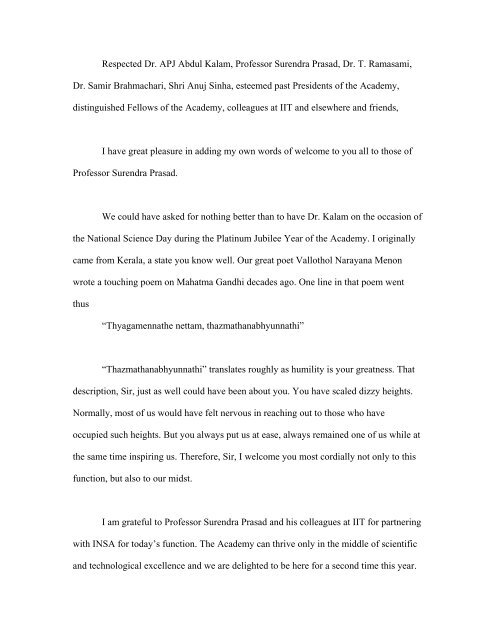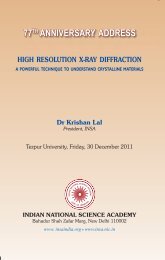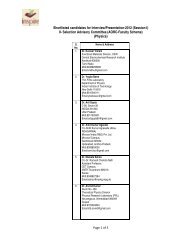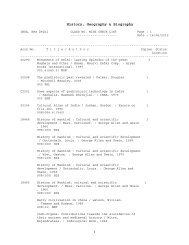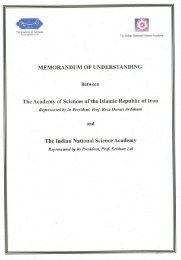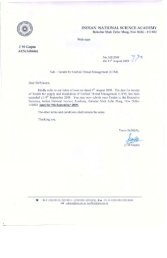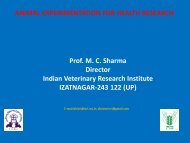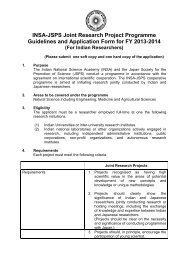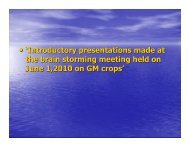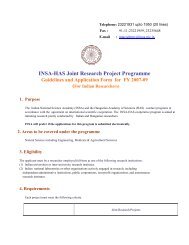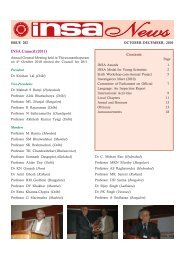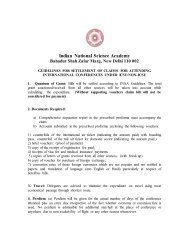science day lecture - Indian National Science Academy
science day lecture - Indian National Science Academy
science day lecture - Indian National Science Academy
Create successful ePaper yourself
Turn your PDF publications into a flip-book with our unique Google optimized e-Paper software.
Respected Dr. APJ Abdul Kalam, Professor Surendra Prasad, Dr. T. Ramasami,Dr. Samir Brahmachari, Shri Anuj Sinha, esteemed past Presidents of the <strong>Academy</strong>,distinguished Fellows of the <strong>Academy</strong>, colleagues at IIT and elsewhere and friends,I have great pleasure in adding my own words of welcome to you all to those ofProfessor Surendra Prasad.We could have asked for nothing better than to have Dr. Kalam on the occasion ofthe <strong>National</strong> <strong>Science</strong> Day during the Platinum Jubilee Year of the <strong>Academy</strong>. I originallycame from Kerala, a state you know well. Our great poet Vallothol Narayana Menonwrote a touching poem on Mahatma Gandhi decades ago. One line in that poem wentthus“Thyagamennathe nettam, thazmathanabhyunnathi”“Thazmathanabhyunnathi” translates roughly as humility is your greatness. Thatdescription, Sir, just as well could have been about you. You have scaled dizzy heights.Normally, most of us would have felt nervous in reaching out to those who haveoccupied such heights. But you always put us at ease, always remained one of us while atthe same time inspiring us. Therefore, Sir, I welcome you most cordially not only to thisfunction, but also to our midst.I am grateful to Professor Surendra Prasad and his colleagues at IIT for partneringwith INSA for to<strong>day</strong>’s function. The <strong>Academy</strong> can thrive only in the middle of scientificand technological excellence and we are delighted to be here for a second time this year.
I trust that to<strong>day</strong>’s joint efforts involving the Ministry of <strong>Science</strong> & Technologyand the <strong>Indian</strong> <strong>National</strong> <strong>Science</strong> <strong>Academy</strong>, orchestrated by Dr. T. Ramasami, ProfessorT.P. Singh and the concerned officers of DST and INSA, would augur well for the future.The <strong>Academy</strong> by its very nature is not an implementer of major policies andprogrammes. It is a lode star that guides and inspires, and is a catalyst. The <strong>Academy</strong> canbe most effective when it works independent of, but in close association with, thegovernment. I think the time is propitious to take this engagement to the next higherlevel. I cannot think of a better constellation of secretaries to <strong>Science</strong> Departments thanwhat we have to<strong>day</strong>. Dr. Ramasami has been key to organizing this function. Two otherSecretaries, Professor Samir Brahmachari and Professor M.K. Bhan, are part of theprogramme to<strong>day</strong>. Then there are Dr. Shailesh Nayak of the Ministry of Earth <strong>Science</strong>sand Dr. V.M. Katoch, DG, ICMR and Secretary for Health Research. All aredistinguished scientists with great vision and commitment.There are plenty of issues on which we need to work together. In recent years,<strong>science</strong> in India has expanded by leaps and bounds. The way and the pace at which<strong>science</strong> is done have undergone a sea change. The structure of <strong>Indian</strong> scientificestablishment, as it exists to<strong>day</strong>, has become unequal to the requirements of modernscientific research. As I mentioned when I welcomed the Prime Minister at theinauguration of our Platinum Jubilee events, we need a vibrant, resilient and sensitivesystem which is less bureaucratic, less hierarchical, more autonomous and moreparticipatory, in order to unleash the creative potential of <strong>Indian</strong> <strong>science</strong>. With ourcollective will and indeed with much good will, understanding and respect for all
concerned, I am confident that it is possible to successfully address this issue.Then there is the issue of policy studies. We have just established a <strong>Science</strong>Policy Cell at INSA under the leadership of Dr. V.S. Ramamurthy who, among otherthings, had earlier served as the Secretary of DST for a long period with great distinction.An important model in this regard is the US <strong>National</strong> <strong>Academy</strong> of <strong>Science</strong>s. The U.S.government seeks the advice of the <strong>Academy</strong> on <strong>science</strong> related issues and the advice ofthe <strong>Academy</strong> is taken seriously. The Royal Society of London also is involved withGovernment in policy formulation. The involvement of INSA in <strong>science</strong> policy has beenperfunctory. It is important to strengthen the role of INSA as a think tank in the service ofthe nation. Here again we hope to be able to work closely with the Government. Thethree <strong>Science</strong> Academies of India together have already begun to address the content ofpost-school <strong>science</strong> education in India. We are now in the process of addressing issuessuch as open access and copyright. There are other policy issues also which we hope tobe able to address in the near future. We would like to seek suggestions and help from theGovernment in this major effort.Then there is the vast area of <strong>science</strong> promotion in which we can all worktogether. The <strong>Academy</strong> by its very nature cannot undertake large projects. That is theprovince of governmental agencies. What the <strong>Academy</strong> is good at is in establishingfruitful relationships, catalyzing programmes and enthusing scientists. For example, wehave an INSA visiting scientist programme which enables scientists from less endowedinstitutions, particularly teachers from universities and colleges, to visit well establishedlaboratories for short periods of time. There are occasions when such short visits have
changed for the better the trajectory of the scientist’s career. Then there is the <strong>science</strong>education programme aimed at bright students and college teachers, jointly run by thethree <strong>science</strong> academies. This programme has had a high catalytic effect. Now we lookforward to participating actively in the INSPIRE programme piloted by Dr. Ramasami.International interactions form an important component of the activities of INSA.Again, INSA does not get involved in large international projects or massive operations.Our emphasis is on low cost, high value efforts. INSA is the national adhering body toICSU which is the international apex body of academies and scientific unions. INSA isclosely involved with many other international scientific organizations as well.Furthermore, INSA has exchange agreements with academies or learned societies ofabout 50 countries. Here the emphasis is on short visits. These exchange visits have beenimmensely useful in fostering fruitful global relationships. Here again INSA and thegovernment need to work in tandem in a complementary manner.Then there is the current effort to reach out to less developed countries,particularly those in Africa. INSA has a centre at Chennai, supported by DST and otheragencies, specifically meant for this purpose. Among other things, it operates a DSTproject and an INSA-JRD Tata Fellowship Programme for researchers and technologistsfrom developing countries. These fellowships are primarily for short visits to <strong>Indian</strong>laboratories and their multiplier effect is enormous. The African countries particularlynow look up to India for help. This came into sharp focus when we were at Mozambiquelate last year for the ICSU General Assembly. China and to some extent Brazil aremaking determined efforts to be engaged with Africa. We need to do the same. There is
certainly the satisfaction of helping out our less endowed brethren. It is also a strategicinvestment. Through these short term fellowship programmes, we can generate enormousgood will and strong relationships at very low cost. We are now looking forward tostrengthening the fellowship programmes for less developed countries. In this context, Iam happy that Professor Samir Brahmachari has agreed to support an INSA-CSIRFellowship programme from the next financial year.INSA does much else, particularly to further its core function of recognizing andpromoting scientific excellence. However, as befitting the occasion, my emphasis to<strong>day</strong>has been on activities in which INSA and the <strong>Science</strong> departments can work together.Despite problems and difficulties, we are in a period of great hopes and expectations.There is a spring in our steps. This is the result of the continuous progress the nation hasmade from the <strong>day</strong> when, to partially quote our first and visionary Prime Minister, at thestroke of the mid-night hour, when the world slept, India woke to new life and freedomand the soul of a nation long suppressed found utterance. Even a decade or two ago,certainly when I went abroad for post-doctoral training in the late sixties, <strong>Indian</strong>s feltthemselves to be under dogs in comparison to those in the advanced west. Many of usreturned to India with fire in our belly, determined to build up <strong>science</strong> in our respectiveareas of endeavour to a level where we can talk to the rest of the world on near-equalterms. We are blessed with an enlightened political leadership and unstinted support fromelders and peers, and the availability of brilliant young men and women in the form ofresearch students. In the councils of the world, including those on <strong>science</strong> andtechnology, India is now taken very seriously. Yet, we still have a long way to go to thesummit of international <strong>science</strong>. However, with our determined joint efforts through a
eformed system and with the involvement of hundreds of thousands of committed brightscientists, across the country, I am sure we would get there in the none too distant future.


